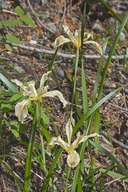|
|
click photo for larger file

Iris bracteata
Siskiyou Iris
|
Photographer: Aaron Schusteff
ID: 0000 0000 0912 0875 (2012-09-15)Copyright © 2012 Aaron Schusteff
|
|
INFORMATION PROVIDED WITH THE PHOTO
|
|
date of photo Jul 7, 2012
location
Near Bear Basin Butte (Del Norte County, California, US)family
Iridaceae
notes I'm have no previous familiarity with the species here, but from studying the treatments in the Jepson Manual (JM2) and Flora of North America (FNA), and consulting other online resources, I believe this is Iris bracteata, perhaps with some in-mixing of I. innominata. Both these species occur in the area, are endemic to the Klamath Region of CA-OR, and are said to hybridize. The JM2 key separates the two by floral tube length, while the FNA key separates them based on whether the cauline leaves are ''bractlike, imbricated, inflated'' vs. ''foliacious, spreading, and not inflated''. Here are some of the salient details I used to arrive at my determination, melded from the species descriptions in JM2 and FNA : I. bracteata: Perianth cream to buff-yellow; floral tube (4)8-9(10)mm; sepals width (15-)25mm; petals (7)8-15(20)mm wide; basal leaves (4)8-10(18)mm wide, many; (1)3-6 cauline leaves imbricate, bractlike; growing in shady forests; I. innominata: Perianth usually dark golden yellow, cream, pink, lavender, or purple; floral tube 15-26(30)mm; sepal width (15)17-26(30)mm; petals (8)9-14(16)mm wide; basal leaves (2)3-4(6)mm wide; (1)2-3(4) cauline leaves; growing in sunny to partly shaded woods. Now here's my reasoning...perianth color of either species fits these plants (due to variability of innominata), but seems a better match for typical bracteata, as does the habitat. I didn't take absolute measurements in the field, but can measure relative length from my photos. From the description info, the ratio of sepal width to floral tube length ranges roughly from 2.5-3.75 for bracteata vs approximately 1 for innominata. I measured the ratios in three flowers visible in the images to be: 1.7, 2.1, and 2.2. Also, the ratio of petal width to basal leaf width ranges roughly from 1.1-1.75 for bracteata vs 2.7-4 for innominata. Measurements from my photos are closer to bracteata here. Also note that at the end of the JM2 description of innominata they remark that that species ''may not occur in CA'' and it is ''sometimes confused...with narrow leaf forms of Iris bracteata''. As far as number of cauline leaves, my images don't show any complete stems...but I counted 4 imbricate cauline leaves on the visible portions of two stems. That's consistent with both descriptions but 'more so' with bracteata (at least in JM2). PS: If any north coast CNPSer's and/or botanists know these two species well and can confirm or correct me here, I'd appreciate your input! photo category: Plant - annual/perennial
|
MORE INFORMATION ABOUT THIS PLANT
|
| common names
Siskiyou Iris (photographer)
Look for Jepson Manual treatments, maps (University & Jepson Herbaria)View Calflora record for Iris bracteataView all photos in CalPhotos of Iris bracteata Check Google Images for Iris bracteata |
|
The photographer's identification Iris bracteata has not been reviewed. Click here to review or comment on the identification. |
|
Using this photo The thumbnail photo (128x192 pixels) on this page may be freely used for personal or academic purposes without prior permission under the Fair Use provisions of US copyright law as long as the photo is clearly credited with © 2012 Aaron Schusteff.
For other uses, or if you have questions, contact Aaron Schusteff arbonius2[AT]sbcglobal.net. (Replace the [AT] with the @ symbol before sending an email.) |
|
|
